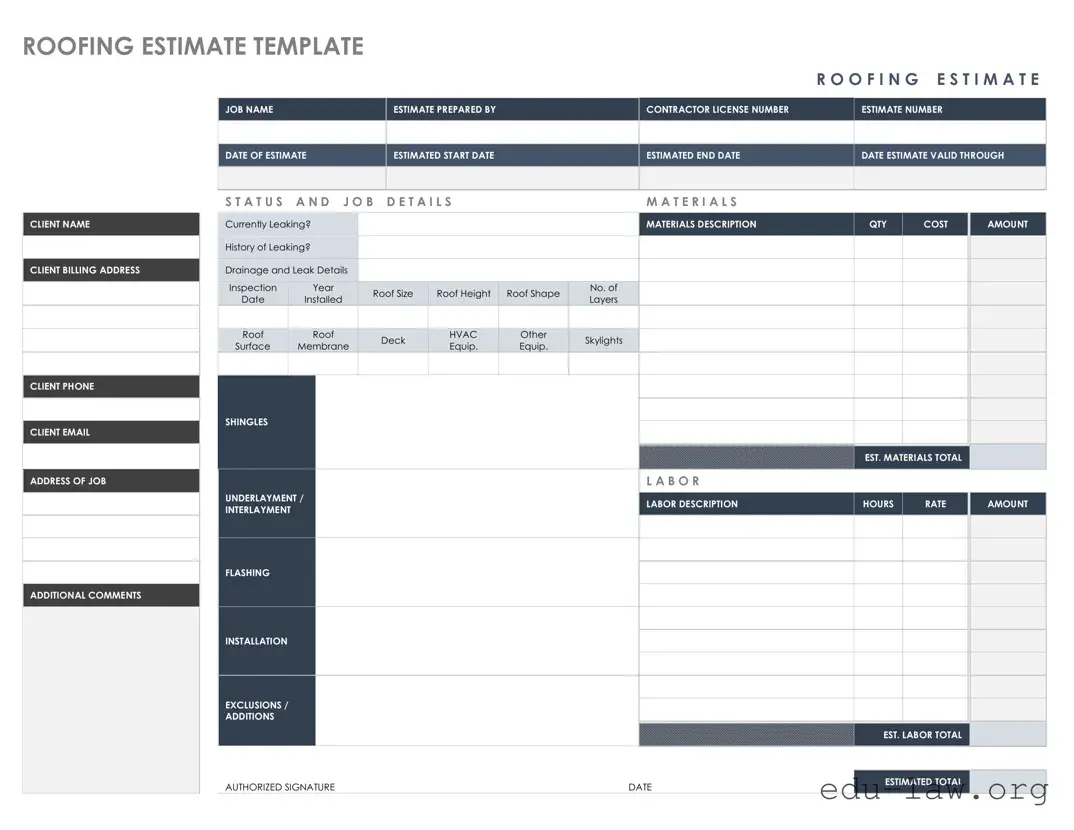The Roofing Estimate form shares similarities with a Quote Request form. Both documents are used to gather information on potential projects and outline the costs involved. Just as the Roofing Estimate requests specifics about roofing materials, labor, and project timelines, a Quote Request collects details from clients regarding their needs. This allows service providers to prepare offers that accurately reflect the required work and associated costs.
A Work Order form often accompanies these estimates. It details the actual work to be completed once the client approves the estimate. While the Roofing Estimate provides a preliminary cost, the Work Order specifies the scope of work, materials to be used, and timelines for project completion. Thus, both documents are critical in transitioning from the planning phase to execution.
Similar to the Roofing Estimate, an Invoice outlines the final billing after a project is completed. Both documents rely on clear communication. While the estimate sets expectations before work begins, the invoice includes the final amounts owed based on the actual work completed. This helps maintain transparency and prevents misunderstandings about costs.
The Service Agreement is another document closely related to a Roofing Estimate. It formalizes the terms agreed upon in the estimate, such as pricing, project scope, and timelines. This agreement provides protection for both parties by clearly defining roles and responsibilities, similar to the clarity sought during the estimation phase.
A Purchase Order is also akin to the Roofing Estimate. While the estimate gives an initial cost assessment, a Purchase Order allows clients to officially request goods or services at a specified price. Both documents serve as formal requests, but a Purchase Order typically follows the acceptance of the estimate and signals commitment to proceed with the project.
The Change Order form is similar in that it addresses modifications to the original Roofing Estimate. During a project, a client may request changes that affect the cost or timeline. A Change Order officially documents these adjustments, ensuring that all parties agree on the new terms, much like how an estimate lays out the initial agreement.
An Acceptance Letter is related to the Roofing Estimate, too. This document signifies the client's approval of the estimate and commitment to move forward. It establishes a mutual agreement based on the terms laid out in the estimate, creating a foundation for the relationship between the client and contractor.
The Contract document is another critical piece. After accepting an estimate, the contract details the legal obligations of both parties. While the Roofing Estimate suggests a cost and scope of work, the contract solidifies those terms and includes conditions for both the service provider and the client. This ensures that there is a formal agreement in place.
Lastly, the Project Timeline is essential and ties back to the Roofing Estimate. It outlines key project milestones and schedules work completion. Like the estimate, it provides clarity on what to expect regarding timing, ensuring that everyone is on the same page about when the roofing project will commence and its expected duration.

